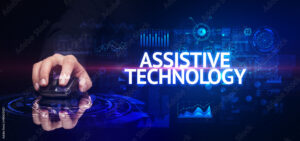Here, I would like to take privilege to pay gratitude to today’s presenters for a well descriptive talk on Assistive Technologies, which is use of any device, equipment or product system to assist or enhance functional capabilities of learners with special needs or disability. It develops equity among diverse learners in education system. It has developed over the years and eased not only people with disability but also people the normal civilians. It is prevalent nowadays in general, professional and academic sectors with variety of its applications. I have been using some of these assistive technological product systems unknowingly that its piece of any assistive technology. In this blog, I will share my experience with those technological products along with its uses, challenges and drawbacks.
icon-tram-black-outline-for-web-site-design-and-mobile-dark-mode-apps-vector-illustration-on-a-white-background-stockpack-adobe-stock
- Dark mode features of mobile phone are the assistance I have been using from last couple of years without knowing the fact that it a kind of assistive technology that help people with visual impairment such as colour blindness. It is the feature common in mobile phones and tablets, which uses light coloured texts or icons against dark background. Night mode on mobile phones also performs the similar function for some people with visual disability. I personally prefers this because of its soothing effect on my eyes while using my mobile phone or tablet for doing my academic work, as a result I could be on screen for more than usual time. It turns out to be more productive academically. However, this feature can be discomfort while using in brightly lit conditions. Sometimes, it may also cause depressing and mourning impact on the readers.

alphabet-letters-with-caption-words-the-concept-of-sentence-usage-or-the-structure-of-something-a-title-or-brief-explanation-accompanying-an-illustration-cartoon-or-poster-stockpack-adobe-stock
- Closed captions or subtitles: I have witnessed multiple times while watching any informative YouTube video along with subtitles or captions on the screen, to assist learners or people who are deaf or hard of hearing or people who are non-native. People who can not hear, can consider it as blessing technology. I have experienced that YouTube app has got a feature which need to be enabled to turn on captions or subtitles and help people with disability to understand the content of the videos. This technology is applicable for video content only. Unfortunately, not all videos may have subtitles. Secondly, someone need to be quick at reading captions.
- Speech to text software: Google Dictation in practiced by me often to help me in writing large texts easily. It converts spoken words into text. Basically, it is a piece of technology designed to assist people with motor impairments, learning or writing disabilities. Accent of speaker, background noises or rapid or quick speech can be drawback that may lead the software to cause error. As a consequence, errors can be made while typing the text.
- Text to speech software: While exploring features on my laptop, I came across this feature, that reads the text aloud and can ease the life on a common civilian and the people with learning disabilities like, Dyslexia or ADHD. It eases the life of learner by not putting much emphasize on our eyes. But it can be heard to use sometimes as the voice quality, using AI tools, can be distracting of hard to understand. It may also cause confusion among learners because of pronunciation errors.

a-seasoned-financial-advisor-presenting-a-comprehensive-webinar-on-stock-trading-basics-aimed-at-new-investors-with-a-professional-virtual-backdrop-and-visual-aids-stockpack-adobe-stock
- Visual Aids: It is a kind of assistive tool that can help people with visual impairment or blindness. I have read a lot about Braille system, which was developed to help people who could not see. It was most popularly and widely accepted technique to help people with disability. It was the part of foundation period assistive technology. They could read without their eyes, using their tactile ability of their hands. It has a downside as prior learning of braille system is required to read the text. Another important tool was screen reader, that could read the screen text aloud for learners with visual disability.
- Hearing Aids: This technology if used by people with hearing impairments, that helps people to converse or engage with others effectively. These tools magnify the noises or sound for disabled people. These tools help people to hear or gather information from the surrounding and help in their interaction with their fellows.
- Mobility Aids: Which help people with physical disability, such as wheelchair. People with disability use those items to commute from one place to another. it induces better mobility among people with physical impairment. It can be disadvantaged as lack of service facilities can be barrier on its way.
High cost of these tools or products can be a major issue among its users as it needs a large amount of money to get or maintain these products. Educational assistive tools can not be available at all the learning institutes. Lastly, Educators are not necessarily Assistive technology competent always. These are some general limitations to use Assistive technology for people with special needs.
In the summary, I would like to say that these Assistive technological tools are a kind of blessing for people with any kind of disability that eases the life of them and leads to equity among diverse learners, especially with disabilities. Although, it has certain drawbacks such as cost effectiveness, availability and lack of AT competency among educators.
For this blog, I have been through article What are the Key Benefits of Assistive Technology?
I have also read https://casls-regina.primo.exlibrisgroup.com/permalink/01CASLS_REGINA/1b4umnc/cdi_proquest_journals_2401680619
I have also watched a YouTube video https://youtu.be/omjVM1lwkII?si=7HGtHCCXSEn5aLFo



Hi Gurjinder, thank you for sharing your experiences with regard to assistive technologies. It’s true that is has developed over the years, and it will only get more advanced in the near future. I enjoyed reading what you have used, especially on you using speech to text software. This is essential nowadays because of the aid it can give to students with learning or writing disabilities. The way you use closed captions or subtitles is also helpful to the students. This is because not all can hear clearly or have difficulty hearing. I personally use subtitles too, if available in the videos I am showing to my students.
It is true that assistive technologies are very helpful to the learners, however, it can get costly for individuals and institutions. Also, lack of competency among many educators in using assistive technologies should be looked at also, especially by governments and schools. This is so that they these different assistive technologies can be utilized in a more effective manner for the learners.
Well done, Gurjinder! You’ve provided a comprehensive overview of assistive technologies and their impact on education and daily life. I appreciate how you reflected on your personal experiences with features like dark mode and speech-to-text.Indeed these tools can be beneficial even for individuals without disabilities. Your discussion of tools like Braille, hearing aids, and mobility aids highlights their transformative potential.The challenges of cost, accessibility, and educator competency exists though. Your conclusion beautifully emphasizes the importance of assistive technologies in fostering equity for all learners.
Hi Gurjinder, great list of assistive tools! I have also used some of them in my everyday life (e.g. the dark mode and closed captions). However, I totally agree with you about the cost of some ATs and their maintenance. I firmly believe that ATs should be affordable because they are a life necessity for some people. Moreover, you are totally right about the fact that ATs are not available at all schools. Spreading awareness about these disadvantages will eventually solve this issue.